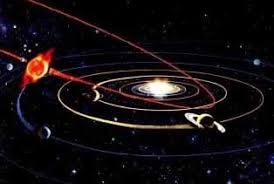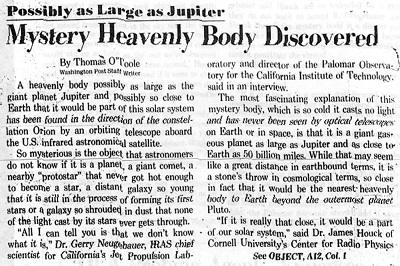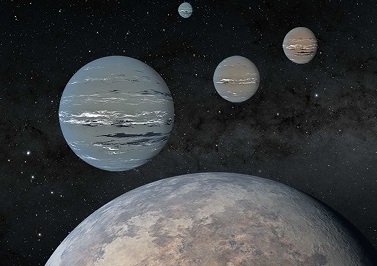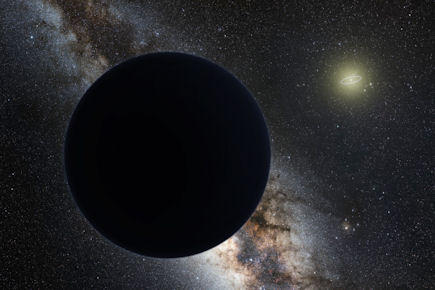
Andy Lloyd's Dark Star Blog

Blog 83 (February - March 2021)
Sitchin's Habitable Moons
When his readers sent him questions about his '12th Planet' ideas, the late author Zecharia Sitchin often wrote back by 'snail mail'. I have a few letters myself, sent all the way from New York to England. A lost piece of correspondence has come to light which demonstrates possibly the first discussion of the Dark Star hypothesis. Author and researcher Al Cornette has had a long-standing interest in Nibiru. Recently, in response to some research discussed on the Dark Star Planet X Google forum, he pulled out a book entitled "The Genius of the Few" by Christian O'Brien. In his copy of this book he found a long-lost letter from Sitchin (dated 28th September 1998) and duly shared it with us.
Image Credit: TheSitchinArchives.com
It's well known that Sitchin claimed that the rogue planet Nibiru/Marduk has/had several moons. He gleaned this information from the ancient Mesopotamian texts which he studied and interpreted. Al Cornette had seemingly spoken with Sitchin at a conference/book signing in Cleveland, and had passed to him a question relating to the habitability of these moons. This is what Sitchin said:
"In response to your question (handed to me in Cleveland) : "Marduk"/Nibiru is a planet, not a star (which a Brown Dwarf is). Still, like other planets, it can (and does) have moons of various sizes and compositions, and so - yes, it is possible that such a moon would be habitable. But if indeed it was/is so, I don't know." (1)
At that time, brown dwarfs were just starting to pop up in sky searches. The first confirmation of the existence of one of these hitherto hypothetical bodies was reported in 1995. As we now know, brown dwarfs span a mass range from 13 to about 80 Jupiter masses. They are considered to be sub-stellar objects which burn out rather quickly. How they are classified as either stars or planets is complicated by where, and how, they form. If they condense independently from a pre-solar nebula, then they are failed stars. If they accrete in a star's planetary zone, and orbit that star, then they're essentially light-emitting planets. These considerations are still contentious now, let alone in 1998.

Image Credit: Andy Lloyd
What is striking about this written correspondence is that Al was asking about the potential role of a brown dwarf as Nibiru/Marduk a full year before I first wrote about this potential connection in 1999. It now seems practically impossible for a full-blown brown dwarf to be wandering about in the outer solar system undetected; and certainly not in a 3600 year orbit. But these ideas were banded around before the infra-red sky searches conducted by WISE and NEO-WISE which significantly dampened hope that such an object might exist within the confines of our solar system. This contrasted with the previous public pronouncements about how IRAS, in 1983, had detected a massive gas giant in the outer solar system (3). This had provoked significant debate (and still does).

Image credit: Washington Post
What remains of keen interest is the potential habitability of a moon in orbit around a significant planet - be it a super-Earth (like the proposed Planet Nine) or a gas giant/sub-brown dwarf located at some considerable distance from the planetary zone of the solar system. This concept still holds, and offers a ready solution to the vexed question of whether Nibiru itself (in whatever guise) could be expected to support life in the depths of the outer solar system. Sitchin's note from 1998 seems to hold open that possibility in his mind. However, he chose not to overhaul his theory accordingly, preferring (in 2010) to allude to internal heating mechanisms within the distant planet; from radioactive sources, for instance (4).
For many of Sitchin's readers and followers, the idea of a Dark Star is somewhat heretical. And, anyway, the super-Earth model emerging from Caltech's Planet Nine offering is closer to Sitchin's original vision (setting aside that pesky 3600 year orbit!). But the man himself was clearly open to other ideas, even in 1998.
Written by Andy Lloyd,
10th February 2021References:
1) Correspondence from Zecharia Sitchin to Al Cornette, 28/9/1998 - with thanks to Al for allowing me to share this information on the Dark Star blog
2) "Brown dwarf"
https://en.wikipedia.org/wiki/Brown_dwarf
3) Thomas O’Toole “Mystery Heavenly Body Discovered” Washington Post, 31st December 1983
4) Andy Lloyd "Book Review: There were Giants upon the Earth" 1st July 2010
The Planet X Legion
A new paper about Planet Nine has re-opened the debate about whether there may be more than one sizeable Planet X object in the outer solar system. As regular readers will be aware, the term 'Planet Nine' was coined 5 years ago to describe a putative super-Earth object lying about twenty times further away from us than even distant Neptune (1). As discussed last month, the term was designed to replace the previous catch-all moniker 'Planet X'. But the association of 'X' with unknown is a stubborn opponent to beat, and I would suggest Planet X is here to stay. Apart from anything else, many folk (and astronomers too) still hanker for the good old days when little old Pluto was the ninth planet, which would make the next proper planet to be discovered number ten. The ancient Romans would thus approve, too.

Image Credit: NASA
This broad approach to what Planet X means correlates well with a stubborn range of values for its mass and orbit, as proposed and argued for (and against) in the astrophysics community. In other words, whilst the Caltech group present a particular range of values for its size and distance (thus defining 'Planet Nine'), other research groups working on the same problem provide evidence that the missing planet conforms to a different set of values. Thus, the catch-all term of 'Planet X' remains relevant.
Image Credit: NASA
For instance, work published last year by a team led by Fienga sets out the constraints of how mass of the planet must vary with its distance (2). The team analysed telemetry data from the Cassini probe to Saturn, and Juno to Jupiter, to ascertain whether there may be anomalous fluctuations in the outer planets' orbits around the Sun. All the planets affect each other, and these effects can be worked out. So, if you account for the gravitational effects exacted by, say. Jupiter, Uranus and Neptune on Saturn's movement around the Sun to provide a calculated position (the ephemeris) for the ringed gas giant, then any inconsistency (which would be extremely subtle) with the observed position might be attributable to another unknown planet further away.
Note that Fienga's work does not confirm the existence of Planet X either way:
"First thing to say is that whatever the considered distances or masses, there is no improvement of the ephemerides by adding P9." (2)
But it does create a useful set of parameters to constrain what is possible. If the planet was large and close, then the effect it would have would definitely be noticeable. Take note, catastrophists. If that effect isn't observed in the telemetry data, then you can say a Planet X object of a certain mass must be a minimum distance of such-and-such. In this case, a Planet X is five terms the mass of Earth, then it must be at least 600 Astronomical Units away (1AU = the distance from the Earth to the Sun). If the planet is 10 Earth masses, then it must be at least 700AU away - and quite possibly quite a bit further (2). And so on.
We might then ask: 'When is Planet X not Planet X?" The not-very-funny punch-line is: 'When its parameters fall within the range stipulated by Caltech for their Planet Nine'.
We might also ask: 'What if there are two or more planets out there?' Planet IX, Planet X, Planet XI etc?
Image Credit: Fauxtoez/Wikimedia Commons
Two Spanish astrophysicists think that the available data points to this conclusion. In 2014, their analyses of the orbits of the Extreme Trans-Neptunian Objects scattered out beyond the usual Kuiper Belt of icy asteroids drew them to the conclusion that there were two unseen perturbers affecting these orbits (3) rather than the one super-Earth object proposed at the time by Trujillo and Sheppard (4). I described these developments in more detail in my 2019 book 'Darker Stars' (5). One of these objects is calculated to be close to 300AU. As Fienga et al's work on Saturn's ephemerides now indicates, that particular object would need to be considerably smaller than 5 Earth masses to not be playing a major role in the gas giant's orbital path. (Sitchinites note that this same argument applies to Sitchin's Nibiru, which would be lodged at a similar distance).
The puzzling issue is that Planet X is shepherding the ETNOs but not affecting the orbits of Saturn or Jupiter. If probes were orbiting Uranus or Neptune, this problem could be probed more deeply, as these more distant outliers would surely feel the subtle tug of Planet X more readily than their inner gas giant cousins.
Recently, the brothers Carlos and Raúl de la Fuente Marcos have carried out further theoretical work on these outer solar system objects. They wondered whether many randomised computations simulating the orbits of unseen planets and their subsequent encounters with ETNOS might create clues about the most likely orbital paths for the perturber/s. Could they find correlations with the field of ETNOs astronomers have observed?
"…the motivation behind this study is the belief that a fossil record of planetary encounters might be preserved in the distribution of the orbital elements of ETNOs. With this hypothesis in mind, we monitored which planetary orbits had the maximum number of potential close encounters with synthetic ETNOs and analyzed the resulting distributions…" (6)
Their statistical analyses looked at the "distribution of nodal distances between two Keplerian trajectories (one ETNO and one hypothetical planet) with a common focus". This was an exercise in pure geometry; quite different from the usual hypothetical work primarily focussed upon gravitational interactions. The good news is that there appears to be a significant effect taking place. Unfortunately, it was not possible to "single out a statistically significant, unique planetary orbit that may be responsible for the orbital architecture observed in extreme trans-Neptunian space" (6). However, more than one Planet X might be capable of creating the observed scattering (and clustering) of the ETNOs.
I wrote to Carlos de la Fuente Marcos to clarify their current opinion about the potential existence of unseen planets in the outer solar system, particularly with regard to their latest paper. He wrote:
"Yes, that work is an attempt at solving an inverse problem and its results are compatible with the presence of more than one massive perturber IF the observed orbits are mostly the result of scattering, in other words, close encounters with yet-to-be-discovered massive perturbers. The closest perturber could be currently located at 300-400 AU from the Sun." (7)
He then went on to consider the perceived clustering of ETNOS and opined that the observed values which have led to Caltech's argument for Planet Nine are instead due to either 'random or uniform behaviour', citing a very recent study which repudiates the clustering effect (8). However, the presence of a perturbing planet may well be affecting the eccentricities of the ETNOs (7).
Written by Andy Lloyd, 10
th-12th February 2021References
:1) Konstantin Batygin & Michael Brown "Evidence for a Distant Giant Planet in the Solar System" The Astronomical Journal, 151:2, 20 January 2016,
2) Fienga, A. "New constraints on the location of P9 obtained with the INPOP19a planetary ephemeris" Astronomy and Astrophysics,640: A6, August 2020
Astronomy and Astrophysics article
3) Carlos de la Fuente Marcos & Ruiz de la Fuente Marcos "Extreme trans-Neptunian objects and the Kozai mechanism: signalling the presence of trans-Plutonian planets", Monthly Notices of the Royal Astronomical Society: Letters, 443: L59, (2014)
academic.oup.com/mnrasl article
4) Trujillo, C. & Sheppard, S. "A Sedna-like body with a perihelion of 80 astronomical units" Nature, 507: 471-474, (2014)
5) Andy Lloyd "Darker Stars" Timeless Voyager Press 2019
6) C. de la Fuente Marcos, R. de la Fuente Marcos “Memories of past close encounters in extreme trans-Neptunian space: Finding unseen planets using pure random searches”, Astronomy and Astrophysics Letters, 646: L14, February 2021
7) Correspondence from Carlos de la Fuente Marcos, 11 February 2021
8) Napier, K. J.; et al “No Evidence for Orbital Clustering in the Extreme Trans-Neptunian Objects” February 2021
Evidence for Planet Nine 'a Mirage'?
This is an argument that has been raging between two scientific groups for some time (as described in my book Darker Stars). The argument boils down to this: Is the evidence for Planet Nine due entirely to observational bias, or is there really a set of clustered data which is so compelling that only a hidden, undetected planet could account for it?

Image Credit: ESO
The Caltech team, who wrote the original 2016 Planet Nine paper, point to a strong correlation between orbital parameters of a cluster of extended scattered disk objects beyond the Kuiper Belt. The correlation between these objects strongly suggests that they have been shepherded by an object beyond their collective environment - in the same way that many trans-Neptunian objects, located closer in, are shepherded by Neptune. As more objects have been discovered the initial clarity of this argument have become muddies. Some new objects share similar characteristics, some don't. Complex arguments about how to properly classify each object then come into play. Are they dynamically stable, like the original cluster, or are they objects which have been subject to other forces thus serving to skew the overall picture unfairly? (1)
The other group (whose numbers seem to gang up on the Caltech Two significantly) work primarily on OSSOS data (the Outer Solar System Origins Survey), but also draw upon Dark Energy Survey and that of astronomers Sheppard and Trujillo (whose early work paved the way for the Planet Nine hypothesis). Let's call this the OSSOS team for simplicity, although it may be a broader conglomerate of minds contributing to its academic output. The OSSOS group think that the Planet Nine hypothesis lacks sufficient evidence; and that the evidence that is there can be attributed to observational bias (2) (a charge which the Caltech team robustly tackled right from the start). Paraphrasing a metaphor used by fellow research John K., the OSSOS team think the Caltech Two have been searching under a lamppost for car keys they dropped in the dark. It's the easiest place to search, but it ignores the dark areas of pavement. Observational bias.
The dynamical arguments to and fro get pretty technical, and neither side look upon this as a wholly black and white issue (although the competitive dimension to this is self-evident). In the end, it's difficult to prove a negative, and the OSSOS team recognise this. The Caltech Two think that OSSOS are not being sufficiently discerning when choosing which objects to consider; but this argument could look a lot like cherry-picking the data. Both sides agree that more powerful telescopes will provide more data, allowing astronomers to search the current dark areas for the keys. It's a much over-used science mantra, I'm afraid, but 'more research is needed'.
Written by Andy Lloyd,
25th March 2021References:
1) Lisa Grossman "Signs of a hidden Planet Nine in the solar system may not hold up" 22 February 2021 with thanks to John
2) K. J. Napier et al. "No evidence for orbital clustering in the extreme trans-Neptunian objects", The Planetary Science Journal, 2(2):59, April 2021.

You can keep informed of updates by following me on Twitter:
![]()
Or like my Facebook Page: https://www.facebook.com/darkstarandylloyd